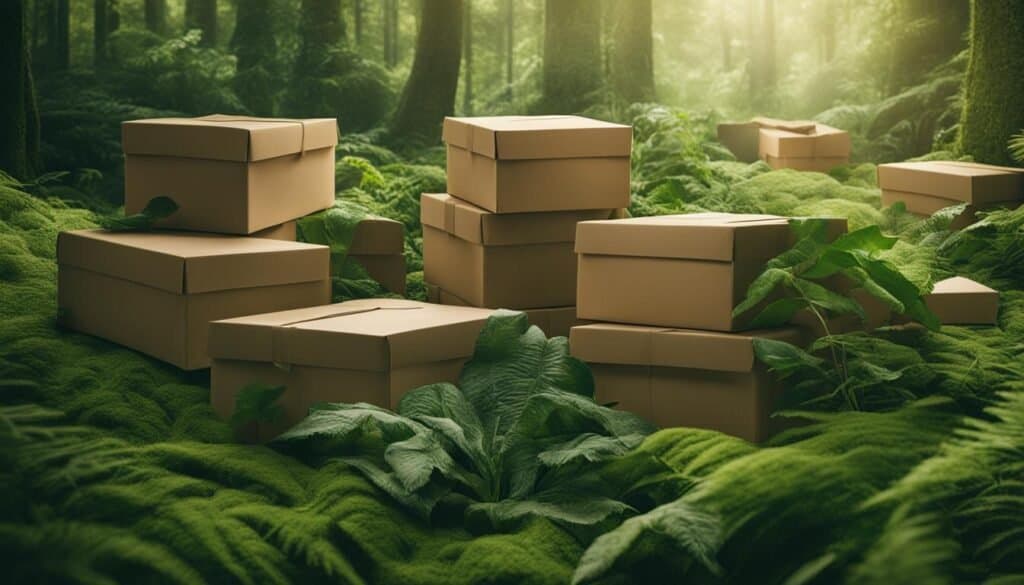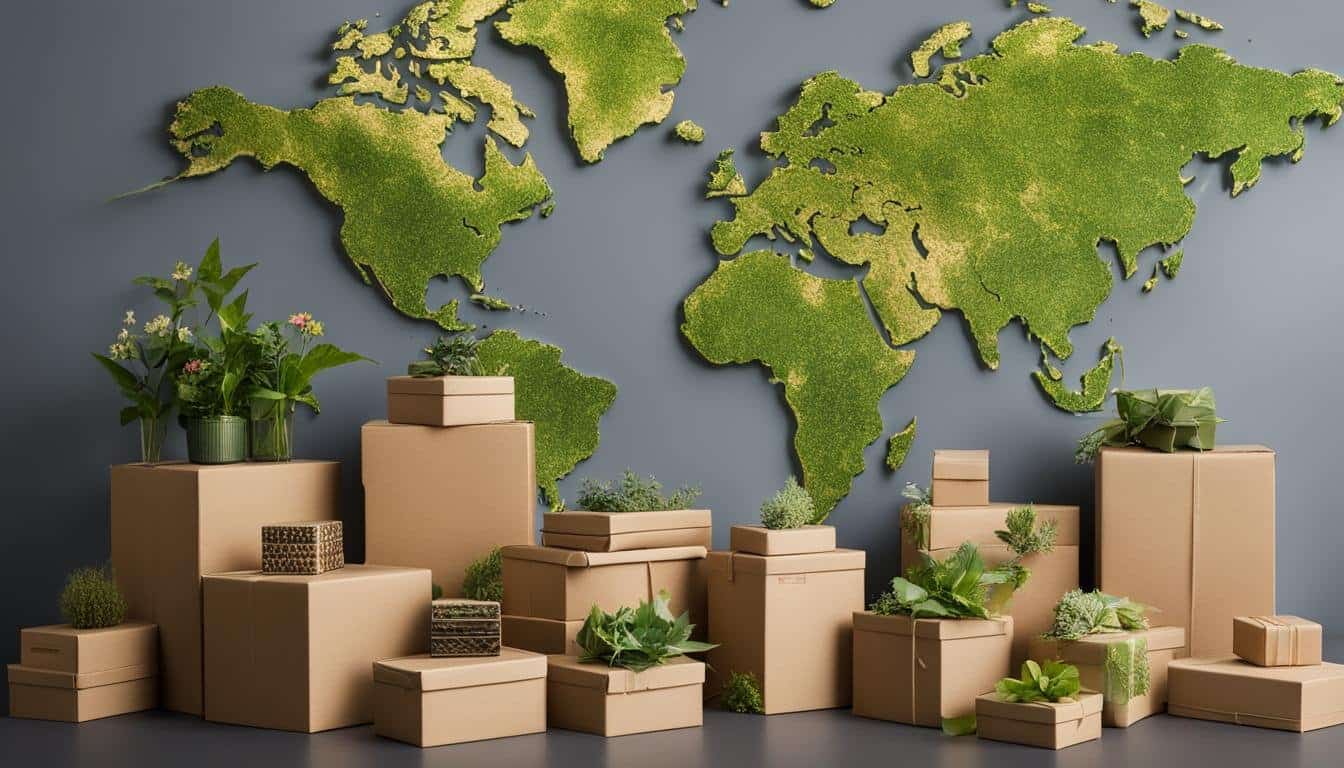As eCommerce continues to experience rapid growth, particularly during the COVID-19 pandemic, sustainable packaging solutions are more critical than ever. Consumers are becoming increasingly aware of the environmental impact of single-use packaging waste and demanding more eco-friendly options. By investing in various sustainable materials, businesses can enhance their sustainability efforts and foster a positive brand perception.
Innovative packaging materials such as compostable packaging and biodegradable materials play a vital role in reducing packaging waste and promoting a more environmentally sustainable future. So, without further ado, let’s dive into 11 fantastic packaging solutions to help you achieve sustainable shipping success!
Key Takeaways
- Sustainable packaging solutions are becoming increasingly crucial for businesses, particularly with the rise of eCommerce.
- Eco-friendly packaging options can help reduce packaging waste while promoting a more sustainable future.
- Compostable packaging and biodegradable materials are two popular environmentally friendly alternatives.
- Sustainable shipping practices can satisfy consumer demand for eco-conscious products and help businesses reduce shipping costs.
- Embracing sustainable materials is an excellent way for businesses to enhance their brand image and achieve long-term success.
The Dawn of Eco-Conscious Packaging and Its Global Impact
As we witness the growing awareness of the environmental impact of packaging, we’ve seen a substantial shift towards eco-conscious packaging. This change is fueled by the adverse effects of single-use plastics on our environment and consumers who have become increasingly vigilant about the footprint of their purchases.
Sustainable business practices are now a significant focus as companies and consumers recognize the need to minimize environmental degradation caused by packaging waste in landfills and oceans.
Packlane.com suggests understanding the lifecycle of your product packaging, including its origin, disposal process, and the carbon footprint involved in transportation and warehousing.
Notable global eco-friendly trends, such as using sustainable materials like bio-based plastics and initiatives like carbon offsets, are rapidly gaining traction. This shift towards environmental packaging positively influences both the industry and its stakeholders. This section will dive into some key aspects of eco-conscious packaging and its far-reaching global impact.
The Power of Consumers and Their Green Choices
As consumers become more environmentally conscious, their preferences shape the packaging landscape. For instance, the demand for biodegradable, recyclable, and compostable packaging has grown exponentially. They are likelier to patronize businesses that demonstrate sustainable practices, bringing environmental packaging into the mainstream.
Widespread Adoption of Sustainable Business Practices
Companies are not only recognizing the environmental benefits of eco-conscious packaging but also the monetary ones. By implementing sustainability initiatives such as using recycled or biodegradable materials, offering refillable containers, and reducing plastic use, they can showcase their commitment to the environment. In the process, they not only strengthen their brand identity but also improve profitability by appealing to a broader and more conscious consumer base.
- Biodegradable materials help reduce packaging waste in oceans and landfills.
- Sustainable business practices provide cost savings and elevate brand value.
- Consumer demand for eco-friendly packaging drives industry innovation and growth.
The Emergence of Innovative Sustainable Materials and Technologies
With the global emphasis on environmentally friendly packaging, creative solutions are emerging to address the need for greener alternatives. New sustainable materials and technologies are being introduced at a breathtaking pace, enabling companies to produce packaging that leaves a smaller environmental footprint. Such innovations include biodegradable materials derived from plants or sustainably sourced paper products and intelligent packaging solutions that reduce energy use and resource consumption.
| Material | Source | Key Benefits |
|---|---|---|
| Polylactic Acid (PLA) | Plant-based feedstocks | Biodegradable, renewable, and compostable |
| Kraft Paper | Sustainably managed forests | Recyclable, biodegradable, and compostable |
| Mushroom-Based Packaging | Mycelium and agricultural waste | Biodegradable, renewable, and low energy requirements |
In conclusion, the dawn of eco-conscious packaging is a testament to an ever-evolving approach towards sustainable business practices shaped by consumers and driven by innovation. As environmental packaging gains widespread appeal globally, it becomes apparent that sustainable efforts are crucial to ensuring a healthier planet for future generations.
Breaking Down the Cost Myth Around Sustainable Packaging
One of the main barriers to the adoption of sustainable packaging, particularly for small businesses, is the perception that it is prohibitively expensive. However, proper implementation can help businesses leverage sustainable packaging to reduce shipping costs, thereby mitigating this cost concern.
Strategies such as transitioning away from plastic, bulk shipping, and using recyclable or compostable materials can contribute to an overall cost savings and eco-friendly shipping processes. Furthermore, implementing sustainable packaging also resonates well with increasingly sustainability-focused consumers, giving businesses an added competitive advantage.
Below, we explore some cost-effective and sustainable packaging alternatives businesses can consider.
- Kraft paper is an affordable, biodegradable option that can replace plastic materials.
- Compostable mailers – made from plant-based materials, offering an eco-friendly alternative to traditional poly mailers.
- Cornstarch packaging is versatile and biodegradable, providing a cost-effective solution for various packaging needs.
Earth.org highlights using plant-based compostable packing peanuts, like those developed by Lush Cosmetics, made from water and a starch-based material.
Additionally, businesses can build a solid business case for sustainability by evaluating the long-term savings and benefits of opting for sustainable packaging. Let’s dive deeper into some cost-saving strategies when implementing eco-friendly packaging.
Cost-Saving Strategies in Sustainable Packaging
Transitioning to sustainable packaging does not necessarily mean incurring higher costs. By employing specific strategies, businesses can enjoy cost savings without compromising their environmental commitment.
“The best way to predict the future is to create it.” – Peter Drucker
- Optimizing package sizes – Reducing unnecessary packaging materials saves costs and minimizes waste.
- Incorporating recycled materials – Sourcing and using recycled materials can be more cost-effective than using new materials while promoting a circular economy.
- Bulk shipping – Combining multiple orders into a single shipment helps lower transportation costs and reduce the environmental impact of shipping.
| Cost-effective Sustainable Packaging Option | Benefits |
|---|---|
| Kraft Paper | Affordable and biodegradable, reducing dependency on plastic |
| Compostable Mailers | Plant-based materials, offering an environmentally friendly alternative to traditional mailers |
| Cornstarch Packaging | Biodegradable and versatile for various packaging needs |
Sustainable packaging should not be perceived as costly but rather as an investment in the planet’s future and the business’s long-term success. By opting for affordable eco-friendly materials and implementing cost-saving strategies, businesses can enjoy the best of both worlds – reducing their environmental impact while keeping costs at bay.
Confronting the Plastic Dilemma with Biodegradable Materials

The ever-growing issue of plastic pollution calls for innovative solutions in the sustainable packaging industry. Biodegradable materials, including polylactic acid (PLA) composites and plant-based bioplastics, offer a promising alternative to conventional packaging materials that take centuries to decompose. Biodegradable packaging can break down under specific environmental conditions without leaving toxic residues, mitigating the plastic dilemma that currently plagues our planet.
The Lifecycle of Biodegradable Packaging in the Environment
A thorough lifecycle assessment is crucial when considering the adoption of biodegradable materials for packaging. This comprehensive evaluation considers the environmental impact of material sourcing, production, use, and ultimate disposal. By understanding the entire lifecycle of biodegradable packaging, businesses can make informed decisions about their choice of environmentally friendly packaging.
The key to effective biodegradable packaging lies in its ability to decompose under specific environmental conditions without harming surrounding ecosystems or leaving toxic residues.
As the market demand for eco-friendly products increases, prioritizing green packaging materials is becoming an essential strategy for companies within the sustainable packaging industry.
Consumer Perception and Market Trends in Biodegradable Options
Consumer perception plays a vital role in the adoption of biodegradable packaging trends. A growing number of consumers are actively seeking products encased in environmentally friendly packaging, making it essential for businesses to adapt to these emerging preferences.
Recent market trends reveal the following developments in biodegradable options:
- Increased consumer demand for sustainable packaging choices;
- Greater availability of biodegradable materials;
- Emergence of environmentally focused certifications and labels;
- Continued innovations in green packaging materials.
These trends, combined with public awareness of environmental issues, drive businesses to prioritize using eco-friendly materials in their packaging strategies.
| Biodegradable Material | Source | Environmental Benefit |
|---|---|---|
| Polylactic Acid (PLA) Composites | Derived from renewable resources such as corn starch or sugarcane | Biodegrades under specific conditions and emits fewer greenhouse gases during production than petroleum-based plastics |
| Plant-Based Bioplastics | Derived from a variety of plant-based materials such as vegetable oils or starch | Biodegrades fully under certain conditions and helps to reduce reliance on fossil fuels |
| Cellulose-Based Materials | Derived from renewable wood sources | Decomposes naturally and contributes to responsible forest management practices |
Businesses that incorporate biodegradable materials into their packaging strategies are taking essential steps toward confronting the plastic dilemma. Companies can align their packaging choices with growing consumer demand for sustainable solutions by adopting eco-friendly materials and prioritizing a thorough lifecycle assessment.
Embracing the Versatility of Recyclable and Reusable Packaging

Recyclable and reusable packaging offers multi-dimensional benefits for sustainability efforts as these practices decrease waste and support a circular economy model. Materials such as corrugated cardboard, glass, and metals are being utilized for their recyclability and reusability, aligning with consumer interests in ethical sourcing and green supply chains and driving product innovation in the packaging industry.
Recyclable packaging, such as corrugated cardboard boxes, metal cans, and glass bottles, significantly reduces packaging waste and helps achieve environmental sustainability. By incorporating recyclable materials in product design, brands can demonstrate their commitment to sustainable practices while addressing consumers’ rising concern about the environmental impact of packaging waste.
On the other hand, reusable packaging takes a step further by extending the packaging’s lifecycle, reducing the need for single-use packaging materials. Reusable packaging examples include reusable shipping crates, bulk containers for grocery shopping, and refillable beverage containers.
Both recyclable and reusable packaging materials contribute to sustainable product design, fulfilling consumer expectations and promoting environmental conservation in the long run.
Packaging waste reduction, environmental sustainability, and sustainable product design are key factors driving the adoption of recyclable and reusable packaging solutions.
| Recyclable Packaging | Reusable Packaging |
|---|---|
| Corrugated Cardboard | Reusable Shopping Bags |
| Glass Bottles and Jars | Reusable Beverage Containers |
| Metal Cans and Containers | Reusable Bulk Containers |
Companies that adopt recyclable and reusable packaging solutions contribute to a more sustainable world and maintain a competitive edge by attracting environmentally conscious consumers. In conclusion, embracing the versatility of recyclable and reusable packaging materials can lead businesses toward enhanced sustainability, cost savings, and improved brand image.
The Evolution of Green Packaging Materials, from Plant-Based to Paper

Innovations in sustainable packaging have expanded beyond traditional methods to incorporate various green packaging materials that cater to the diverse needs of businesses and consumers. Today, we witness an astonishing array of plant- and paper-based packaging solutions that align with environmental stewardship and resource efficiency while fulfilling the growing demand for functional and sustainable options.
How Sustainable Forestry Practices Influence Paper-Based Packaging Choices
As the popularity of paper-based packaging continues to soar, so does the need to source raw materials responsibly. This is where sustainable forestry practices make a significant impact. These practices ensure that the packaging materials are derived from well-managed forests with certified sustainability standards, resulting in various ethical packaging solutions.
The emphasis on responsible sourcing is reflected in the development of paper and paperboard packaging options that balance environmental concerns with the demand for functional and sustainable packaging.
Organizations like the Forest Stewardship Council (FSC) and the Sustainable Forestry Initiative (SFI) are responsible for setting standards and certifying sustainable paper products. When businesses and consumers opt for certified sustainable paper, they can be confident in their choice of packaging material and take pride in contributing to a greener planet.
Here are some examples of eco-friendly packaging solutions within the realm of plant-based and paper packaging:
- Plant-based foam and cushioning
- Bagasse-based containers
- Paperboard or cardboard boxes
- Straw-based packaging
- Molded pulp packaging
The future of green packaging materials is not only in the hands of manufacturers and businesses but also the conscious consumers who drive the demand for eco-friendly alternatives. By choosing renewable resources and supporting sustainable forestry practices, we can all play our part in preserving our planet for generations.
Integrated Technology in Packaging Innovation

As the packaging industry embraces sustainable solutions to minimize its environmental impact, integrating innovative technologies plays a crucial role in developing eco-friendly packaging. Let’s explore some critical sustainable packaging technologies that have emerged to reshape how products are packaged and delivered.
From advanced materials to smart designs, integrated technologies are paving the way for a greener future in the packaging industry.
Atomic Layer Deposition for Enhanced Packaging Performance
Atomic Layer Deposition (ALD) is a cutting-edge thin-film technology that helps improve the barrier properties of packaging materials. ALD enables thick coatings of just a few nanometers, which effectively protect the packaged product from external factors such as moisture, oxygen, and light while maintaining a lightweight design. This innovative technique allows for development of high-performance, eco-friendly packaging to reduce material usage and waste.
Biocomposites: Combining Nature with Technology
Biocomposites are materials made from natural fibers and biodegradable polymers, which can offer improved strength and durability compared to traditional packaging materials. These composites aid in minimizing environmental impact by deriving their materials from renewable sources, reducing dependency on non-renewable materials, and offering enhanced end-of-life options, such as biodegradability or compostability.
- Wood-plastic composites (WPC) – made from fibers of wood and biodegradable plastics
- Natural fiber composites (NFC) – created from plant-based fibers and biodegradable polymers
Smart Active Packaging: Extending Shelf Life and Reducing Waste
Innovative active packaging is an emerging eco-friendly packaging design approach that integrates sensors and other technologies to extend the shelf life of perishable products, ultimately reducing food waste. These intelligent packaging systems can monitor and regulate the environment within the package, ensuring optimal conditions for maintaining product quality.
| Type of Smart Active Packaging | Description | Examples |
|---|---|---|
| Gas scavengers | Regulate humidity within the package to prevent condensation and microbial growth. | Oxygen absorbers, ethylene scavengers |
| Moisture control | Inhibit the growth of microorganisms on the product’s surface to prevent spoilage and extend shelf life. | Desiccant sachets, moisture-absorbing films |
| Antimicrobial agents | Inhibit the growth of microorganisms on the product’s surface to prevent spoilage and extend shelf life | Antimicrobial films, sachets containing natural antimicrobial substances |
These integrated packaging solutions not only contribute to preserving our environment but they also enhance product quality and brand reputation. By harnessing the power of advanced technologies, the packaging industry can continue to develop innovative and sustainable options, aligning with the global push for a greener future.
From Seed to Package: The Circular Economy of Sustainable Packaging
The concept of a circular economy is integral to sustainable packaging. By prioritizing materials that can be recycled and reused, we minimize waste and maintain a closed-loop system. This approach applies not only to the production of bio-based plastics but also extends to implementing closed-loop systems in business operations. The result is a more sustainable supply chain and a heightened focus on total lifecycle sustainability in packaging solutions.
Embracing a circular economy comes with a range of benefits, such as:
- Fewer packaging materials entering landfills
- Reduced dependency on virgin raw materials
- Support for local recycling infrastructure
- Improved brand reputation and consumer relations
- Enhanced resource conservation through reduced waste
Companies can facilitate the implementation of a circular economy in packaging by adopting strategies such as:
- Choosing sustainable packaging materials that are easily recyclable or compostable
- Implementing closed-loop systems to collect, process, and reuse packaging materials
- Encouraging consumers to recycle packaging through effective communication and education
- Collaborating with industry partners and local recycling facilities to enhance waste management processes
- Continuously innovating to develop zero-waste packaging solutions that cater to evolving consumer preferences
Promoting a circular economy in the packaging industry is vital for tackling the pressing global challenge of resource conservation.
On a global scale, many companies and organizations are working towards adopting sustainable packaging solutions aligned with the principles of the circular economy. Examples include Loop, a zero-waste shopping platform that partners with major brands to offer products in reusable containers, and TerraCycle, a recycling company that specializes in hard-to-recycle materials such as flexible packaging and snack wrappers.
The circular economy concept is a crucial component of sustainable packaging, as it ensures comprehensive lifecycle sustainability and promotes resource conservation. The packaging industry can contribute to a healthier environment and forge a more sustainable future by focusing on circularity.
The Role of Sustainable Design in Packaging Efficiency

Sustainable design plays a crucial role in packaging efficiency and waste reduction. Packaging can be made compact and lightweight by considering aspects such as shape and size. This approach optimizes the use of materials and reduces shipping costs and environmental impact. Practical, sustainable design should minimize resource use while maintaining packaging performance.
Minimizing Waste through Design: The Importance of Shape and Size in Packaging
Packaging shape and size are critical factors for determining any product’s efficiency and waste reduction capabilities. Material usage can be significantly reduced by designing packaging to be as compact and lightweight as possible. This decrease in resource consumption can offer significant cost savings for businesses while promoting eco-design principles and minimizing waste.
Some examples of sustainable design strategies include:
- Using the right-sized packaging, which allows for minimal excess material usage
- Optimizing packaging shapes for efficient transportation and storage, which can reduce shipping costs and lessen the amount of space required for warehousing
- Incorporating collapsible or stackable designs to save space during transportation and storage
By implementing sustainable design principles, companies can provide environmentally conscious options to consumers while benefitting economically from the efficient use of resources.
Effective sustainable design should focus on minimizing resource use, without compromising on packaging performance.
Furthermore, sustainable design in packaging can also encourage consumers to dispose of packaging materials responsibly as they become more aware of the eco-friendly options available. Considering packaging shape and size feeds into businesses’ commitment to minimizing waste and promoting sustainability throughout their operations, leading to greater accountability and a more responsible approach to resource use.
In conclusion, sustainable design, particularly concerning packaging shape and size, is integral to promoting packaging efficiency and minimizing waste. By implementing eco-design principles and optimizing packaging designs, businesses can better respond to environmentally conscious consumers’ demands, reduce costs, and contribute to a more sustainable future.
Conclusion on Sustainable Packaging Solutions
In exploring various sustainable packaging solutions, we have gained valuable insights into how businesses can reduce their environmental footprint and meet consumer expectations. By adopting eco-friendly materials and design strategies, sustainable shipping practices are becoming a reality and contributing to a more positive global environmental impact.
The progression towards an eco-friendly future relies on the continued development and integration of advanced technologies within the packaging industry. As innovations unfold, businesses should remain proactive in adopting and incorporating these practices into their operations, signaling their commitment to environmental stewardship and appealing to the growing sustainability-conscious market.
Ultimately, sustainable packaging is not just a trend but an essential element in the fight against environmental degradation. By embracing these diverse solutions, businesses can forge a path toward a greener future, meeting the expectations of an increasingly environmentally-minded consumer base while benefiting from more efficient, cost-effective shipping processes.
FAQ on Eco-friendly Packaging
Q: What is the importance of sustainability in packaging?
A: Sustainability in packaging is crucial as it aids in reducing the carbon footprint by minimizing the utilization of resources during production. It not only helps the environment but also builds a positive image of the brand among consumers, making it a strong business case for business owners.
Q: What would you recommend as eco-friendly packaging alternatives to traditional plastic packaging?
A: Many eco-friendly packaging alternatives are emerging. Some of these include compostable packaging materials, bamboo packaging, and bio-based materials, all of which are designed to be biodegradable or recyclable, reducing their impact on the environment.
Q: Can compostable and eco-friendly packaging materials match the durability and efficiency of old packaging materials?
A: Yes, many compostable and eco-friendly packaging materials are designed to be as durable and efficient as traditional materials without causing harm to the environment. Examples include mushroom packaging, bioplastics, and edible packaging, among others.
Q: How are packaging companies incorporating sustainability into their supply chains?
A: Packaging companies are incorporating sustainability into their supply chains by using materials that are compostable, recyclable, or made from renewable resources. They also reduce waste by creating custom packaging that fits the product exactly, eliminating the need for excess materials.
Q: How are sustainable packaging materials used in the food industry?
A: Sustainable packaging materials are widely used in the food industry. Bio-based materials, for example, are often used for food packaging since they are biodegradable and compostable. Additionally, many restaurants and food businesses use compostable containers, and some are even exploring edible packaging solutions.
Q: What are some examples of leading sustainable packaging solutions?
A: Leading sustainable packaging solutions include bamboo packaging, mushroom packaging, and packaging produced from recycled materials. Such packaging is used by companies who are conscious about their carbon footprint and understand the importance of sustainable practices.
Q: How can business owners make a business case for changing to eco-friendly packaging solutions?
A: Business owners can make a business case for eco-friendly packaging by highlighting the environmental benefits, cost savings from reduced material use, and improved brand reputation among consumers. There’s also an increasing demand for sustainable products and packaging from buyers, reinforcing the business case for such a change.
Q: How do compostable packaging products contribute to product sustainability?
A: Compostable packaging products contribute to product sustainability by reducing waste that ends up in landfills. Since they’re made from plant-based materials, they decompose naturally in a composting environment, returning to nature and completing the lifecycle in a sustainable manner.
Q: Would you suggest custom packaging as a way to achieve packaging sustainability?
A: Yes, custom packaging can play a significant role in achieving packaging sustainability. By creating packaging that matches the product size exactly, the use of excess material can be limited, reducing waste and enhancing sustainability.
Q: Are there any guidelines for business owners looking to invest in eco-friendly packaging?
A: Business owners can reference manuals like the packaging buyers guide to help them understand what packaging types are available, their benefits, and best uses within their industry. It’s also recommended to partner with packaging companies that offer sustainable packaging solutions, ensuring that the packaging materials you use are in line with your business’s sustainability goals.





Leave a Reply